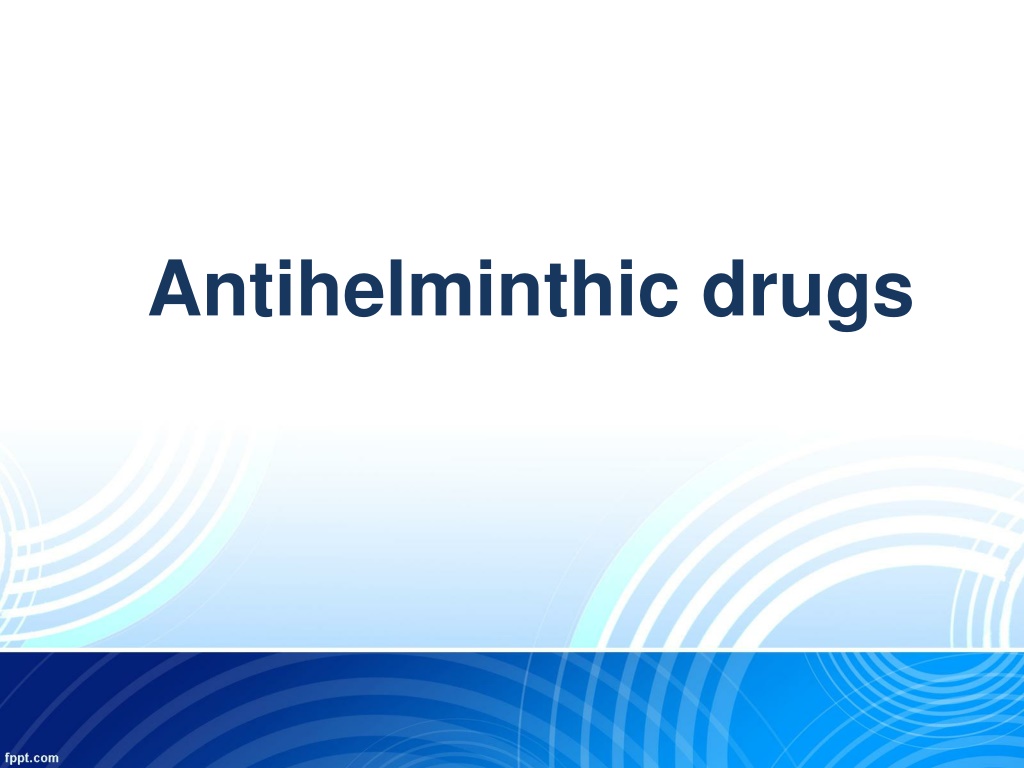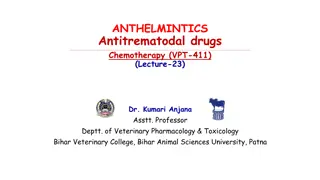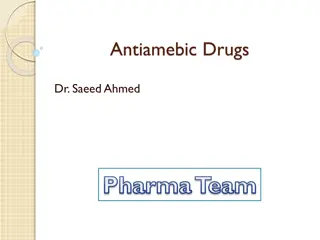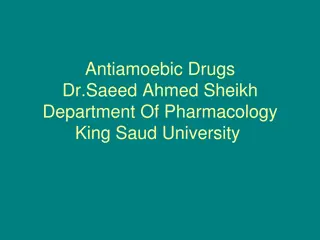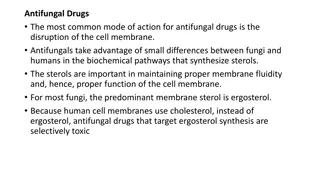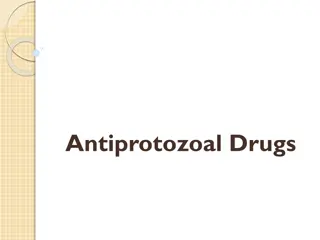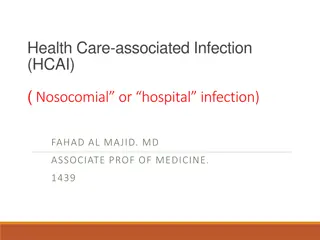Understanding Antihelminthic Drugs and Helminth Infections
Among the most common chronic infections worldwide are those caused by parasitic helminths, leading to serious health issues. Learn about the types of helminths, their impact on human health, and the mechanisms of antihelminthic drugs in treating these infections.
Download Presentation

Please find below an Image/Link to download the presentation.
The content on the website is provided AS IS for your information and personal use only. It may not be sold, licensed, or shared on other websites without obtaining consent from the author. Download presentation by click this link. If you encounter any issues during the download, it is possible that the publisher has removed the file from their server.
E N D
Presentation Transcript
Among the most widespread of all chronic infections are those caused by various species of parasitic helminths (worms). For example, it is estimated that over half the world's population may be infected with gastrointestinal helminths. Inhabitants of tropical or subtropical low- income countries are most at risk; especially in children. In some cases (e.g. threadworms), these infections result mainly in discomfort and do not cause substantial ill health, but others, such as schistosomiasis (bilharzia) and hookworm disease, can produce very serious morbidity. Because of its prevalence, the problem of the treatment of helminthiasis is therefore one of very great practical therapeutic importance.
HELMINTH INFECTIONS: The helminths comprise two major groups of multicellular worms: the nemathelminths (nematodes, roundworms) and the platyhelminths (flatworms). The latter group is subdivided into the trematodes (flukes) and the cestodes (tapeworms). Almost 350 species of helminths have been found in humans, and most colonise the gastrointestinal tract. * The main examples of worms that live in the host's alimentary canal are : Intestinal roundworms: Ascaris lumbricoides (common roundworm), Enterobius vermicularis (threadworm called also pinworm), Trichuris trichiura (whipworm), Strongyloides stercoralis (threadworm ), Necator americanus and Ankylostoma duodenale (hookworms). Tapeworms: Taenia saginata, Taenia solium, Hymenolepis nana and Diphyllobothrium latum. -*The main examples of worms that live in the tissues of the host are: - Flukes: Schistosoma haematobium, Schistosoma mansoni, and Schistosoma japonicum. These cause schistosomiasis (bilharzia). -Tissue roundworms: Trichinella spiralis, Dracunculus medinensis (guinea worm) and the filariae, which include Wuchereria bancrofti, Loa loa, Onchocerca volvulus and Brugia malayi. -Hydatid tapeworm. These are cestodes of the Echinococcus species.
ANTIHELMINTHIC DRUGS The antihelminthic therapies generally act by incapacitating the parasite by paralysis (e.g. by preventing muscular contraction), damaging the worm such that the immune system can eliminate it, or by altering its metabolic processes (e.g. by affecting microtubule function). Because the metabolic requirements of these parasites vary greatly from one species to another, drugs that are highly effective against one type of worm may be ineffective against others. Clearly, to be an effective antihelminthic, a drug must be able to penetrate the tough exterior cuticle of the worm or gain access to its alimentary tract in sufficient concentrations. Many helminths contain active drug efflux pumps that reduce the concentration of the drug in the parasite. Therefore, the route and dose of antihelminthic are important and must be chosen carefully, as the parasitic worms cannot be relied on to consume sufficient amounts of the drug.
Principal drugs used in helminth infections and indications for their use
BENZIMIDAZOLES One of the principal groups of antihelminthics used clinically are the benzimidazoles. This group of broad-spectrum agents includes mebendazole, tiabendazole and albendazole. They are thought to act by inhibiting the polymerisation of helminth -tubulin, thus interfering with microtubule-dependent functions such as glucose uptake. They have a selective inhibitory action (250-400 times). However, the effect takes time to develop and the worms may not be expelled for several days. Cure rates are generally between 60 and 100% with most parasites. Only 10% of mebendazole is absorbed after oral administration, but a fatty meal increases absorption. It is rapidly metabolised, the products being excreted in the urine and the bile within 24-48 hours. It is the drug of choice for for Enterobius vermicularis, hookworm and whipworm .It is generally given as a single dose for threadworm, and twice daily for 3 days for hookworm and whipworm infestations. Tiabendazole is rapidly absorbed from the gastrointestinal tract, very rapidly metabolised and excreted in the urine in conjugated form. It is effective for guinea worm and Strongyloides infestations.
Albendazole is also poorly absorbed but, like mebendazole, this may be increased by food, especially fats. It is metabolised extensively by first-pass metabolism to the sulfoxide and sulfone metabolites. It is the drug of choice for hydatid disease &strongyloides stercoralis. Unwanted effects : Are few with albendazole or mebendazole, although gastrointestinal disturbances can occasionally occur. Unwanted effects with tiabendazole are more frequent but usually transient, the commonest being gastrointestinal disturbances, although headache, dizziness and drowsiness have been reported and allergic reactions (fever, rashes) can occur. Mebendazole should not be given to pregnant women (teratogenic) or children less than 2 years old because of reports of convulsions in this age group.
PRAZIQUANTEL Praziquantel is a highly effective broad-spectrum antihelminthic drug. It is the drug of choice for all forms of schistosomiasis and is the agent generally used in large-scale schistosome eradication programmes. It is also effective in cysticercosis. The drug affects not only the adult schistosomes but also the immature forms and the cercariae-the form of the parasite that infects humans by penetrating the skin. The drug apparently disrupts Ca2+homeostasis in the parasite by binding to protein kinase C-binding sites in a subunit of schistosome voltage-gated calcium channels .This induces an influx of the ion, a rapid and prolonged contraction of the musculature, and eventual paralysis and death of the worm. Praziquantel also disrupts the outer coverings of the parasite, unmasking antigens, and as a result it may become more susceptible to the host's normal immune responses.
Praziquantel is rapidly absorbed after oral administration and distributes into the cerebrospinal fluid. High levels occur in bile. The metabolites are inactive and are excreted through the urine and bile Praziquantel is considered to be a very safe drug with minimal side effects in therapeutic dosage. Such effects as do occur are usually transitory and rarely of clinical importance. They include gastrointestinal disturbance, dizziness, aching in muscles and joints, skin eruptions and low-grade fever. Effects may be more marked in patients with a heavy worm load because of products released from the dead worms It is considered safe for pregnant and lactating women.
PIPERAZINE Piperazine can be used to treat infections with the common roundworm (A. lumbricoides) and the threadworm (E. vermicularis). It reversibly inhibits neuromuscular transmission in the worm, probably by mimicking GABA. It is administered with a stimulant laxative such as senna to facilitate expulsion of the worms. Unwanted effects may include gastrointestinal disturbances, urticaria and bronchospasm. PYRANTEL PAMOATE Pyrantel pamoate is highly effective for the treatment of pinworm, ascaris and hookworms The drug is a neuromuscular blocking agent that causes release of acetylcholine and inhibition of cholinesterase; this results in paralysis, which is followed by expulsion of worms. Pyrantel pamoate is poorly absorbed orally and exerts its effects in the intestinal tract. Unwanted effects: are infrequent, mild, and transient. They include nausea, vomiting, diarrhea, abdominal cramps.
NICLOSAMIDE Niclosamide is widely used for the treatment of tapeworm infections together with praziquantel. The scolex (the head of the worm with the parts that attach to the host intestinal cells) and a proximal segment are irreversibly damaged by the drug, presumably due to Inhibition of the mitochondrial phosphorylation of adenosine diphosphate (ADP) in the parasite, making it lethal for the cestode s scolex and segments but not for the ova. Anaerobic metabolism may also be inhibited. The worm separates from the intestinal wall and is expelled. Unwanted effects: are few, infrequent and transient. Nausea and vomiting can occur.
DIETHYLCARBAMAZINE Diethylcarbamazine is a piperazine derivative that is the drug of choice for filarial infections caused by W. bancrofti and L. loa. Diethylcarbamazine rapidly removes the microfilariae from the blood circulation and has a limited effect on the adult worms in the lymphatics. It has been suggested that it modifies the parasite so that it becomes susceptible to the host's normal immune responses. It may also interfere with helminth arachidonate metabolism. It is rapidly absorbed following oral administration with meals and is excreted primarily in the urine. Unwanted effects: are common but transient, subsiding within a day or so even if the drug is continued. Side effects from the drug itself include gastrointestinal disturbances, arthralgias, headache and a general feeling of weakness. Allergic side effects referable to the products of the dying filariae are common and vary with the species of worm.
LEVAMISOLE Levamisole is effective in infections with the common round-worm (Ascaris lumbricoides). It has a nicotine-like action, stimulating and subsequently blocking the neuromuscular junctions. The paralysed worms are then expelled in the faeces. Ova are not killed. Unwanted effects: are generally few and soon subside. They include gastrointestinal disturbances, dizziness and skin eruptions. It can cause more serious effects, notably agranulocytosis, and it has been withdrawn from North American markets.
IVERMECTIN It is a safe and highly effective broad-spectrum antiparasitic in humans. It is used for the treatment of many filarial infections. It has also given good results against W. bancrofti, which causes elephantiasis. A single dose kills the immature microfilariae of O. volvulus but not the adult worms. Ivermectin is the drug of choice for onchocerciasis, which causes river blindness and reduces the incidence of this disease by up to 80%. It is also active against some roundworms: common roundworms, whipworms, and threadworms, but not hookworms. Ivermectin targets the glutamate-gated chloride channel receptors. Chloride influx is enhanced, and hyperpolarization occurs, resulting in paralysis and death of the worm. Unwanted effects: include skin rashes, fever, dizziness, headaches and pains in muscles, joints and lymph glands. In general, the drug is very well tolerated
